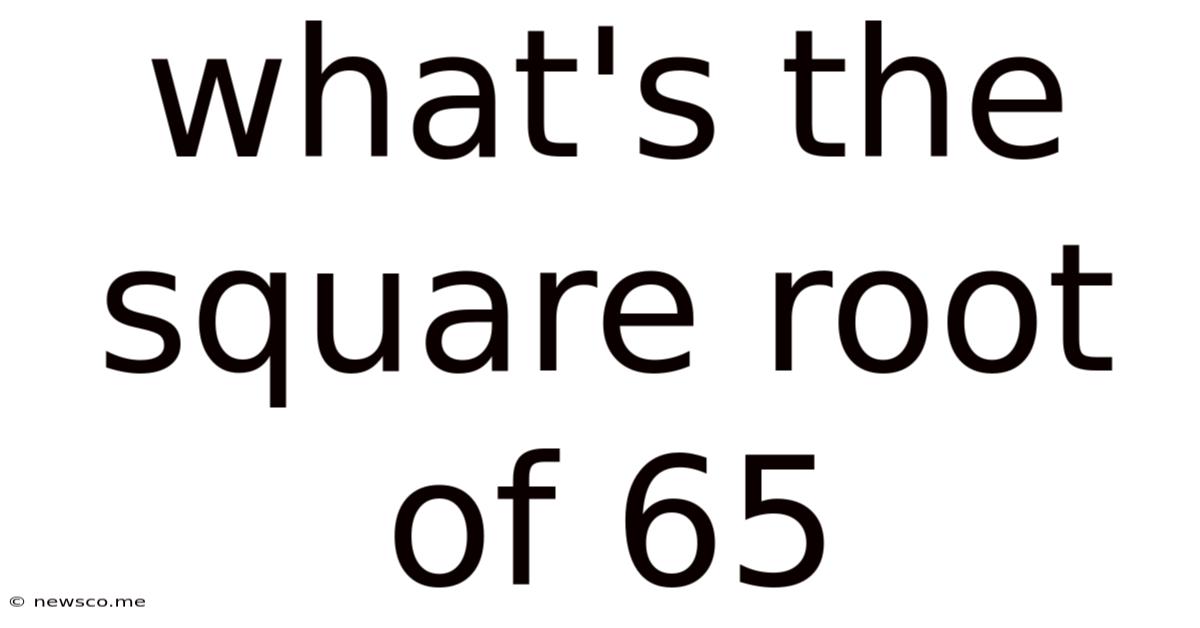What's The Square Root Of 65
News Co
Mar 23, 2025 · 4 min read

Table of Contents
What's the Square Root of 65? A Deep Dive into Approximation Methods and Mathematical Concepts
The question, "What's the square root of 65?" seems simple enough. A quick glance at a calculator provides a seemingly straightforward answer: approximately 8.062257748. However, the journey to understanding this answer, and the mathematical concepts surrounding it, is far more enriching than a simple numerical result. This article will explore various methods for approximating the square root of 65, delving into the underlying mathematical principles and highlighting their practical applications.
Understanding Square Roots: A Fundamental Concept
Before diving into the approximation methods, let's solidify our understanding of square roots. The square root of a number (x) is a value (y) that, when multiplied by itself, equals x. Mathematically, this is expressed as: y² = x. Therefore, the square root of 65 is the number that, when multiplied by itself, equals 65.
This seemingly simple concept has far-reaching implications across various fields, from physics and engineering to computer science and finance. Understanding square roots is crucial for solving quadratic equations, calculating distances, and understanding geometric relationships.
Methods for Approximating the Square Root of 65
Since 65 is not a perfect square (meaning it's not the result of squaring a whole number), finding its exact square root involves an irrational number—a number that cannot be expressed as a simple fraction. This means we must rely on approximation methods. Let's explore several:
1. The Babylonian Method (or Heron's Method)
This iterative method is one of the oldest and most efficient ways to approximate square roots. It involves repeatedly refining an initial guess until the desired level of accuracy is achieved. The formula is:
xₙ₊₁ = ½ (xₙ + S/xₙ)
Where:
- xₙ is the current approximation
- xₙ₊₁ is the next approximation
- S is the number whose square root we're seeking (in this case, 65)
Let's illustrate with an initial guess of 8:
- x₁ = 8
- x₂ = ½ (8 + 65/8) ≈ 8.0625
- x₃ = ½ (8.0625 + 65/8.0625) ≈ 8.062257748
As you can see, even after just a few iterations, we've achieved a highly accurate approximation. The Babylonian method converges quickly, making it a powerful tool for approximating square roots.
2. The Newton-Raphson Method
A more sophisticated iterative method, the Newton-Raphson method, is also applicable. It's based on finding the root of a function, in this case, f(x) = x² - 65. The iterative formula is:
xₙ₊₁ = xₙ - f(xₙ) / f'(xₙ)
Where:
- xₙ is the current approximation
- f(xₙ) = xₙ² - 65
- f'(xₙ) = 2xₙ (the derivative of f(x))
This method, while more complex to understand initially, also converges rapidly to the correct answer.
3. Using a Taylor Series Expansion
For those comfortable with calculus, a Taylor series expansion offers another approach. This involves representing the function √(x) as an infinite sum of terms. By choosing an appropriate center point (a value close to 65 whose square root is known) and truncating the series after a few terms, we can obtain a good approximation. The accuracy depends on the number of terms included.
4. Linear Approximation
A simpler, yet less accurate, method is linear approximation. This involves finding the tangent line to the function y = √x at a nearby point whose square root is known. For example, we know √64 = 8. The tangent line at x = 64 can be used to approximate √65. While straightforward, this method provides a less precise approximation compared to iterative methods.
Beyond the Calculation: Applications of Square Roots
The seemingly simple calculation of the square root of 65 has far-reaching applications across numerous disciplines:
1. Geometry and Trigonometry
Square roots are fundamental in calculating distances, areas, and volumes in geometric figures. For instance, the Pythagorean theorem (a² + b² = c²) relies heavily on square roots to determine the hypotenuse of a right-angled triangle. This is crucial in fields like surveying, architecture, and engineering.
2. Physics and Engineering
Many physical phenomena involve square roots. For example, calculating the velocity of an object undergoing freefall uses the square root in the formula. Likewise, in electrical engineering, impedance calculations often involve square roots.
3. Computer Graphics and Game Development
Square roots are extensively used in computer graphics for various calculations, including determining distances between points, normalizing vectors, and performing rotations. This is essential in creating realistic 3D environments and simulating physics in games.
4. Finance and Economics
Square roots appear in financial models, for instance, in calculating standard deviation (a measure of risk) and portfolio optimization strategies.
5. Statistics and Data Analysis
Square roots play a significant role in statistical analysis. They are used in calculations related to standard error, variance, and correlation coefficients.
Conclusion: The Square Root of 65 and Beyond
While the answer to "What's the square root of 65?" might appear simple at first glance (approximately 8.062257748), exploring the various methods for approximating this value unveils a deeper appreciation for mathematical principles and their practical applications. From the ancient Babylonian method to the sophisticated Newton-Raphson technique, each approach offers a different perspective on how to tackle this seemingly simple problem. The significance extends beyond the calculation itself, illustrating the fundamental role square roots play across various fields, shaping our understanding of the world around us. Understanding these methods and their implications is key to tackling more complex mathematical challenges and contributing to innovation across various disciplines.
Latest Posts
Related Post
Thank you for visiting our website which covers about What's The Square Root Of 65 . We hope the information provided has been useful to you. Feel free to contact us if you have any questions or need further assistance. See you next time and don't miss to bookmark.